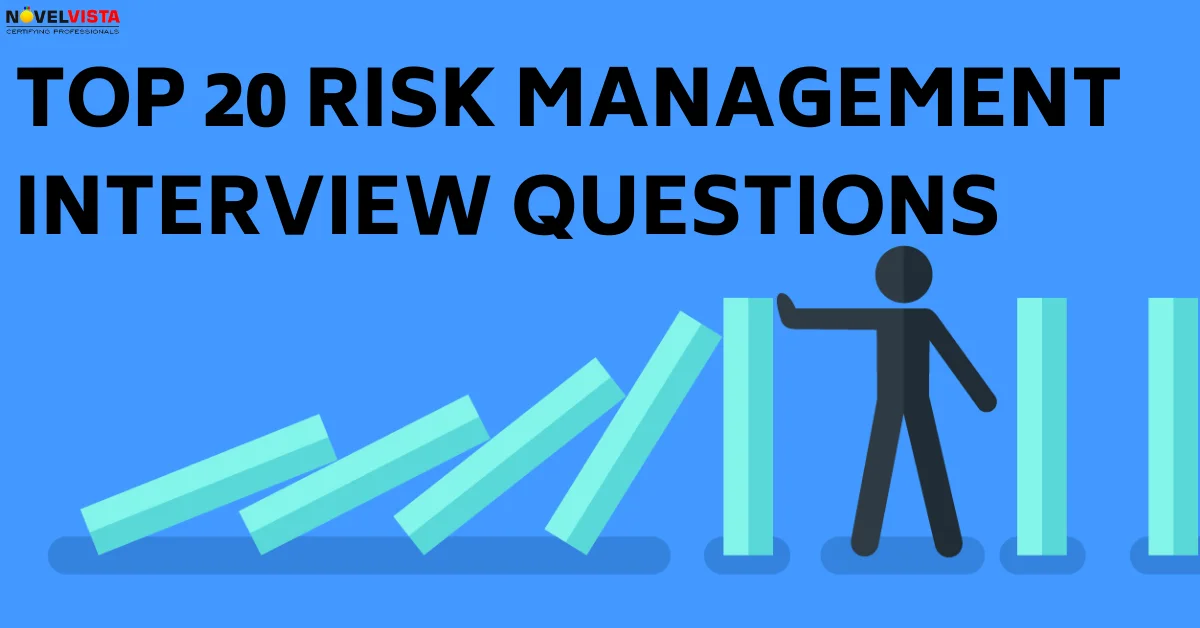Enroll Now and Get Upto 30% Off
* Your personal details are for internal use only and will remain confidential.

Last updated 22/12/2023

Risk management has transformed into an essential function in today's rapidly evolving business landscape, ensuring the business's success and resilience. The requirement for skilled Risk Management Strategies has been on the rise and driven by the increasing complexity of risks faced by businesses across the industrial sectors. Today, we will dive into questions about risk management to prepare yourself for interview.
Prepare for your Risk Management Interview with our compilation of the Top 20 questions on risk management. Here, you will explore general, technical, and experience-based questions that are well-aligned to make your risk management career successful.
What is Risk Management?
Risk Management is the identification, evaluation, and prioritization of risks, which are defined in ISO 31000 as the effect of uncertainty on objectives followed by coordinated and economical application of resources to minimize, monitor, and control the probability of unfortunate events or to maximize the realization of opportunities.
Due to the high demand, we have simplified the top risk management interview questions and answers just for you.
Here you go!
Business risk includes the financial, cybersecurity, operational and reputational risks and all of these has significant impact on success of business if appropriate action were not immediately. Managing the business risk at the strategic level needed have constant focus on emphasizing more than five to ten risks. Day-to-Day risks are an ongoing operating responsibility.
Businesses must need to renew or change their risk assessments and management’s practices once in every 3 years. On the other hand, whenever there to any significant changes to workplace processes or design, or any machinery introduced the assessment practices needs to be change. The robust practices for identifying and prioritizing the critical enterprise risks that includes emerging risks is important to evergreen view of the top risks.
Once the risks are targeted, someone or the group member must own them. Gaps and overlaps in risks ownership need to minimize if not eliminated.
Assessing the businesses proficiency in managing the primary risks includes the strong system monitoring for overseeing, controlling every critical risk. Successful risk management relied on ongoing enhancement of risk management capabilities to keep pace with the evolving speed and complexity of business dynamics.
The cultural problems and dysfunctional behaviour mostly undermine the effectiveness of risk management and lead to inappropriate risk taking or undermining the developed policies and procedures. Like, the lack of transparency, conflicts of interest, a shoot the messenger environment or unbalanced compensation structures may encourage the undesirable behaviour and compromise the effectiveness of risk management.
Most of the time it happens that, business gets comfortable with their business strategies, model’s and approaches but this is where they fails to identify the changing paradigms until it’s too late. As the business environment changes, monitoring the validity of critical assumptions over time is a wise move since no one knows what might invalidate the company's strategic assumptions in the future.
The risk appetite dialogue helps to provide the balance to the conversation around which risks the enterprise should take, which risks it should ignore and the parameters within which it should operate going forward. The risk appetite statement is disintegrated into the risk tolerances to rectify the questions like, how much variability are we willing to accept as we pursue a given business objective? The example will be great to understand that, separate risk tolerances might be expressed in different ways for objectives which are relevant to earnings variability, interest rate exposure and the acquisition, development and retention of people.
The risk reporting began with the relevant information about critical business related risk and how those risks are well managed.
Critical event mostly address by the business in strategic side of business resilience which began with identifying business risks, business continuity planning, forming crisis management teams and the tactical part of implementing business continuity. Also, the communal strategies are used like avoidance, retention, transferring, and sharing and loss reduction.
In order to provide input to executive management with respect to critical risk issues on timey basis, directors must need to understand the industry and the changing environment along with its impact on business model. The required set should need to involve the understanding of the risks inherent in the corporate strategy and the risk appetite of management in executing that strategy, accesses useful information from external and internal sources regarding critical assumptions underlying strategy, etc.
While the departmental roles and responsibilities are different among the businesses, most of the businesses place ultimate responsibility for Enterprise Risk Management with their Board of Directors.
Without a designated accountable individual for risk management, identifying, prioritizing, and mitigating risks across the organization are unlikely to occur periodically and comprehensively. To ensure an effective and controlled process, it is more important to have a named individual than details such as their title, budget, or number of employees in today's dynamic marketplace.
As the failures are often happens because of strategic risk which has been addressed rather than catastrophic storm or single cyberattacks. Such as, it’s dynamic for businesses to know and deal with their strategic risks. These risks includes:
Beside this, most significant risks to the strategy involves the potential market fluctuations, technological disruptions and competitive compression. In order to address this, business needs to develop the proactive monitoring systems to detect the market changes as soon as possible. Next, regarding the ongoing investments in research and development, it would be important to make sure that technology used in business remain cutting edge. It’s essential to maintain the collaboration with industry professional and continues marketing analysis which allows employees to stay ahead of competitors while strategic partnerships offers collaborative approach to navigate the uncertainties.
Strategic and non-strategic risks of particular magnitude needs to be combined into one risk register that allows management and the board to see the major risks, what is being done to reduce the risks, what is the procedure against the risk mitigation plan. The board needs to see the report to they should ask for one if it’s not already being created.
The risks basically depend on the industry and operations of businesses. Still, there are some communal risks faces by business as follows:
Particularly the individual performance plan focuses on employee’s goals, tasks and professional development, etc. But with respect to risk management it also contributes in different approaches. It can include alignment with businesses goals, skill development, accountability and responsibility, etc.
The chief security officer or chief information security officer is responsible for overall cybersecurity and infosec policy. A security director is the senior level professional that oversees the applications within business.
Accountability for Information Technological security is crucial, basically in amid the high risks of cyber breaches and threats like service demands and extortion. To develop the secure technological platform, businesses must need ensure that the expertise by hiring professionals or collaboration expert contractors. In light of recent breaches, it is imperative to have an experienced Chief Information Security Officer (CISO), since their absence or newness might contribute to vulnerabilities.
If there is hot-line, then it shows that the business is seriously interested in identifying risks and that the topic of risk is being handled fairly transparently within the business. If there isn’t any one then board might be wonder why there is no channel for the rank and file to alert management about the risks.
Large and Small businesses have the potential to harbor correlated risks. These risks are the group of risks that might occur at the same time because there is a relationship of some sort among them. It might include, communal locations, an individual resource with the multiple ties. It might also be in terms of chain reactions. One risk event might causes the risks, which is often true in the case of natural disasters like hurricanes.
A disaster recovery plan is importantly the response component of business continuity plan. It encompasses the processes, technologies and objectives necessary for fulfilling a quick recovery after a disaster.
The aim of business continuity plan is keeping all of some of the business running from another place or with backup systems or whatever allows continuous operations. Beside this the disaster recovery plan has the mission to restore the basic operations as quickly as possible after the business has been interrupted in whole or in part.
Insurance could be an effective and efficient approach to manage the risk when it’s used in the well-constructed fashion. The board will want to consider high level complexities are, the right set of risks which are less predictable, needed special expertise and are beyond the financial ability of business.
To assess the effectiveness of risk management, the board can inquire about the analysis behind the insurance program, including the type of analysis conducted, the responsible party, and the availability of benchmark information from similar organizations. These questions provide a solid starting point to gauge the organization's risk management efforts.
There are different range of risk management interview questions might asked by the board so you must prepare yourself with the basic knowledge. These are the excellent starting place for getting the idea of well the business is addressing risk.
The above explained interview questions for risk management will help you to get to know the nature of interview patterns and how should you answer the questions without any complexities.
Conclusion
We trust that you have perused this blog and comprehended the Top 20 risk management questions and answers. Engaging a career in Risk Management provides the substantial compensation and benefits. The strong preparation is crucial for interview success, and you can accomplish it by practicing with these provided questions and answers. Don’t settle for this only, join our Certified ISO 31000 Risk Manager training sessions and we will tell you more about risk management and its core factors.
NovelVista Learning Solutions is a professionally managed training organization with specialization in certification courses. The core management team consists of highly qualified professionals with vast industry experience. NovelVista is an Accredited Training Organization (ATO) to conduct all levels of ITIL Courses. We also conduct training on DevOps, AWS Solution Architect associate, Prince2, MSP, CSM, Cloud Computing, Apache Hadoop, Six Sigma, ISO 20000/27000 & Agile Methodologies.
* Your personal details are for internal use only and will remain confidential.